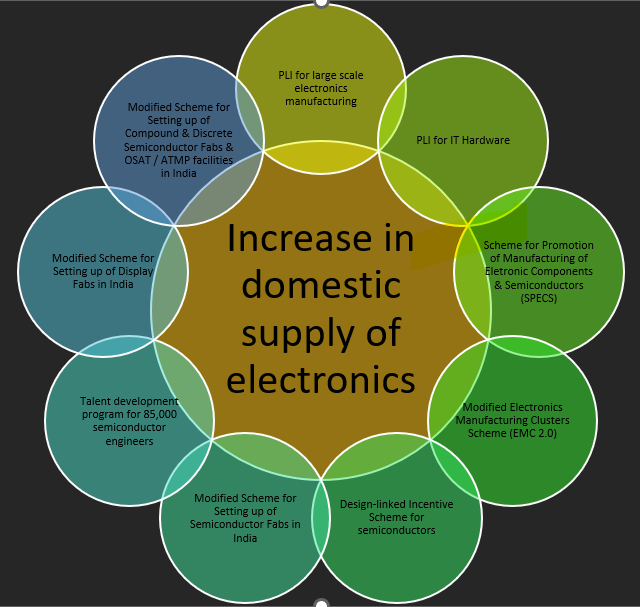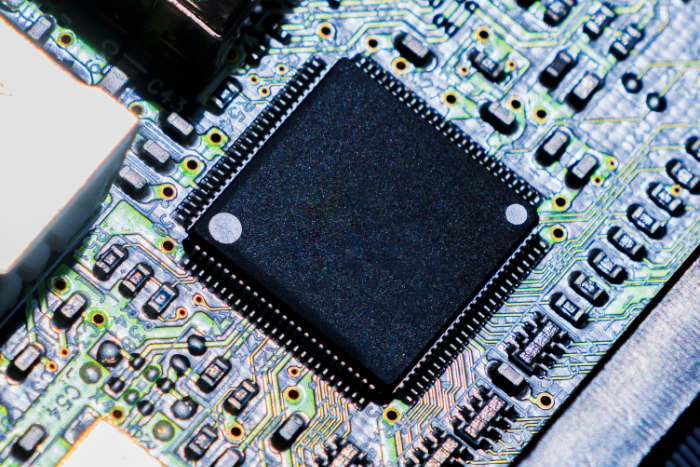The focus of India’s semiconductor policies has been largely techno-economic. Acknowledging socio-political realities in these policies can create an inclusive domestic semiconductor market, and ensure inclusive economic development
It is no secret that India is looking to boost its domestic EV manufacturing. An important piece of this puzzle is the production and use of semiconductors. The government is looking to make India a semiconductor manufacturing hub in the world. It recently approved India’s fourth semiconductor unit— a proposal by Kaynes Semicon Pvt Ltd to set up a unit in Sanand, Gujarat, with a capacity to manufacture 60 lakh chips per day. These will be designed for a wide variety of applications, including EVs, automotives, and consumer electronics.
As part of the global EV30@30 campaign, India’s EV policy aims to ensure annual sales of 1 crore units by 2030, and this increased EV production and consumption is expected to generate 5 crore direct and indirect jobs by 2030. India’s EV policy further lays down the following sales penetration targets to be achieved by 2030: 30% in private cars, 70% in commercial vehicles, 40% in buses, 80% in two-wheelers, and 80% for three-wheelers.
This increased policy push for EV production and consumption has increased the domestic demand for semiconductors that are used in most critical components of EVs such as Advanced Driver Assistance Systems (ADAS), battery management systems, power electronics, and infotainment systems.
Now with a total of four semiconductor units in India across the value chain – from fabrication to assembly, testing, and packaging – the semiconductor market in India is rapidly expanding, and is expected to reach $32 billion by 2025, with a concomitant growth in India’s EV market size projected to be $113.99 billion by 2029.
But some questions arise here – do the semiconductor policies in India foster an inclusive market economy? Do they account for the country’s socio-political disparities to facilitate a just transition? And do they take measures to create a sustainable domestic semiconductor economy, to reduce India’s import dependence on China?
Attracting private investment a priority for India
The following figure summarises the various tech policies that are governing the semiconductor industry in India. As can be seen, the government is using a combination of subsidies and incentives to attract private investments to build a sustainable semiconductor value chain in India.

This continued policy intent of increasing the domestic manufacturing and design capabilities of the Indian semiconductor industry has been made evident by the recent budgetary allocations, too. The Interim Budget 2024-25 had allocated ₹6,903 crore for the semiconductor sector. On top of this, in the Union Budget that was laid down in July post elections, the Modi government allocated ₹21,936 crore to the Ministry of Electronics and Information Technology (MeitY) – the ministry that administers the PLI schemes for electronics and semiconductors.
The key to unlock investor trust
The focus of India’s semiconductor policies, as can be seen from the above, has been majorly techno-economic, they have been pro-business and not pro-market, and have failed to garner the required investor trust in entering the Indian market.
For example, the policies focus on incentivising startups in the domestic design industry. They promote domestic IP protection, building international partnerships for tech transfer, and laying down a long-term strategy to make India a dominant player in the international semiconductor market. But they have ignored the socio-political aspects of this technological transition — like ensuring equitable access to skilling and technical training programs for all sections of society, ensuring easy access to semiconductor markets for MSMEs and low-skilled workers, laying down decent work guidelines in semiconductor manufacturing plants to prevent health risks from dangerous chemicals used in manufacturing the semiconductors, and to integrate circularity and natural resource conservation in the semiconductor business models.
Acknowledging socio-political realities in semiconductor policies can create an inclusive market in India’s domestic semiconductor market, and ensure inclusive economic development.
Such a human-security centred semiconductor policy would foreground human well-being at the heart of security concerns posed by semiconductors, by encompassing non-traditional threats to human well-being, like economic, social, environmental, and health concerns in the policy. Some examples of such non-traditional threats to human well-being in the context of creating a sustainable semiconductor economy would include:
- Semiconductor startups in India face a dearth of risk capital, which hinders domestic decentralised innovation and R&D in innovative and possibly low-cost chip design. This continues India’s structural dependence on the existing tech superpowers like China, the USA, Taiwan, South Korea, Japan, and some European countries like the Netherlands.
- The semiconductor industry being a super high-tech field, requires specialised training to be imparted to prospective chip designers and engineers. India currently lacks the educational infrastructure needed to conduct the skilling programs at scale.
- Semiconductor manufacturing facilities are water and energy intensive, and will increase the energy intensity of India’s economy, and make it difficult to adhere to its NDCs under the Paris Agreement.
- Workers involved in semiconductor manufacturing are routinely exposed to dangerous chemicals like polychlorinated biphenyls (PCBs), hydrofluoric acid, glycol ethers, and carbon monoxide, all of which may cause cancer, miscarriages, or birth defects if appropriate design and safety measures are not taken by the manufacturing facilities.
The policy should, therefore, focus on addressing root causes of security vulnerabilities arising from globally integrated semiconductor value chains, and should prioritise building domestic partnerships & resilience, and localising business strategies.
As can be seen in Figure 2 below, centring human-security in semiconductor policies would focus not only on sustaining the economics of semiconductors in the long run, but also to create a value chain that is accessible to the people of India, either as workers, business owners, or customers.

The way forward
One way of creating an inclusive semiconductor domestic market would be to mandate recruitment of locals, especially in the low-skilled and semi-skilled workforce that would be needed in maintaining the manufacturing and Assembly, Testing, and Packaging (ATP) premises. This policy intervention, along with creating greater gender parity in STEM education in general, and semiconductor technology training in particular, can make the Indian semiconductor market more participatory, equitable, and politically sustainable in the long run.
The recent initiative by the Ministry of Tribal Affairs in association with IISc, to train 2,100 tribal students in semiconductor technology for three years is a step in the right direction, towards creating an inclusive chip market in India. The recent abolishment of angel tax for all classes of investors starting FY 2025-26 also has a positive impact on the domestic semiconductor startup ecosystem. This has made financing for smaller players easier, as startups are now no longer required to pay taxes on excess amounts received for issuing shares beyond their market value.
But the following reforms will make the existing semiconductor policy even more inclusive:
- Incentivising green behaviour: Providing incentives for chip fabrication and ATP plants that take measures towards environmental conservation, ranging from the use of renewable energy, water conservation (for example, by improving efficiency to produce ultra pure water/UPW used in semiconductor manufacturing, replacing wet photoresist etching processes with dry plasma etches, reusing and recycling water, and practising rainwater harvesting), greening the surrounding villages/towns they are situated in, investing in green chips R&D.
- Scaling up industry-academia partnerships for domestic R&D, skilling: Apart from the proposed skilling programme for 85,000 engineers, scaling up academia-industry collaborations to create a domestic R&D ecosystem for semiconductor design will help ensure supply chain stability and security. Currently, such partnerships are being carried out by select engineering institutes like IIT Madras, IIT Hyderabad, and IIT Bombay. MeitY must proactively facilitate the diversification of fabless chip design talent pool, given the projection that India will need 1 million high-tech engineers to meet the demands of the growing ESDM sector.
- Prioritising sustainable and inclusive business models in the semiconductor value chain: The ISM policy framework should lay guidelines to make the semiconductor fabrication and ATP business models more inclusive, by way of facilitating greater participation of women, marginalised communities, and smaller businesses in the value chain, while preserving the economics of production. For example, flexi-staffing approaches may be followed in the transport and logistics related to the semiconductor industry, and local hiring can be mandated in O&M of the buildings.
Integrating these socio-political aspects in the current semiconductor policy that is techno-economic in its focus, will help India realise its dual goals of protecting national security, and advancing inclusive economic development.
Views expressed are personal.
About The Author
You may also like
American tech companies to invest billions to build AI infra in India
India says it won’t rely on global climate or pollution rankings to shape policies
Why India’s Clean Cooking Revolution Must Be Electric
Ola Cuts FY26 Revenue Forecast as Focus Shift to Profitability
COP30 Kicks Off With Hard Talks on Money, Adaptation and Global South Leadership

